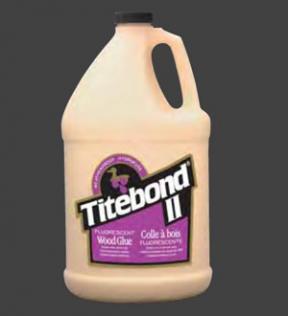Tool review – fluorescent glue
Glow-in-the-dark glue
I compared Titebond Fluorescent Wood Glue and Titebond III to the PVA glue I normally use. The idea behind fluorescent glue is that once you’ve finished a project, you can use a black light to check if there are any spots of glue squeeze-out remaining on the wood that will keep stain from going on evenly. The thicker the glue, the more it fluoresces; even a fingerprint stain is obvious under black light. Overall, I can see where the fluorescing would make cleaning up squeeze-out easier.
Both Titebond glues seemed slightly tackier than my normal glue. I laid a bead of glue on two boards and rubbed them together before tightening the clamps. The Titebond-glued boards did not shift or slide at all.
My next test was to make mitred biscuit joints. After applying only hand-pressure clamping, all the joints remained tight. After 30 minutes, I could not pull any of the joints apart. To test their strength further, I used a dead blow hammer to try to break the joints. The fluorescent glue was at least as good as my normal glue, and the Titebond III seemed slightly stronger. It was the only glue joint where the biscuit also broke.
In a test for shrinkage, I dabbed equal amounts of the glues on a board and left them to dry overnight. Both Titebond glues shrank less than my normal glue.
Titebond Fluorescent Wood Glue costs $11 for 946 mL, while Titebond III costs $6 for 237 mL. For more info, call 800-347-4583 or visit www.titebond.com.
To leave a comment, please log in












No comments